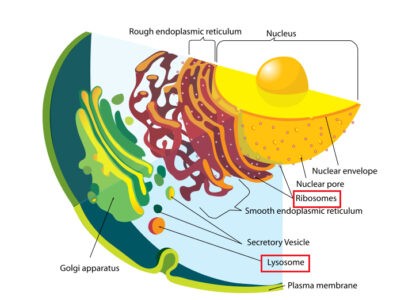There are various cell organelles in the cell. They do many important functions inside the cell. Among the cell organelles, lysosomes are present in the eukaryotic cells while both prokaryotic and eukaryotic cells bear ribosomes.
Lysosomes are bounded by membrane and different types of digestive enzymes are present here. It is also known as the garbage disposal system of cells which destroy unwanted garbage materials from the cell. Lysosomes are capable of degrading all types of polymers of the cell because they contain an array of digestive enzymes.

Image showing diagram of lysosome

Lysosme and Phagocytocys
Ribosomes are small in the structure which is made up of ribosomal RNA and proteins. Ribosomes perform to synthesize protein from RNA. Hence it is also called the protein synthesizing machine. The ribosome has two subunits. Prokaryotic cells contain 70S ribosomes which comprise of 50S and 30S subunits. In a eukaryotic cell, ribosomes are the 80S which contain the 40S and 60S subunits. The difference between ribosome and lysosome are stated in the following table:

The Cell showing Ribosome

Ribosome Subunit
|
Lysosome |
Ribosome |
|---|---|
|
The lysosome is present in the cytoplasm of the eukaryotic cell only. |
The ribosome is present in the cytoplasm of both prokaryotic and eukaryotic cell. |
|
The lysosome is larger in size than ribosome which ranges from 0.1 to 1.2 µm. |
Ribosomes are typically smaller in size than lysosome which ranges 20 to 30 nm. |
|
It is covered by a unit membrane i.e., it is membrane-bound organelle. |
It is not covered by the membrane i.e., it is non-membranous organelle. |
|
These are evenly and freely distributed throughout the cytoplasm. |
These are freely distributed throughout the cytoplasm as well as these remain attached with the membrane of the endoplasmic reticulum etc. |
|
It consists of a single part. |
It consists of mainly two parts. |
|
It is a minute spherical vesicle filled with hydrolytic enzymes and small vesicles. |
It is a minute spherical structure of ribonucleoprotein and contains no vacuoles. |
|
It always remains separate from each other. |
Ribosomes are grouped together during protein synthesis and forms polyribosome. |
|
Functionally it is of four types; Primary lysosome, secondary lysosome, residual body, and autophagosome. |
According to size, the ribosomes are two types; 80S and 70S. |
|
It is responsible for digestion of protein along with other substances of the cell. |
It is responsible for the digestion of protein synthesis. |
|
It is discovered by Cristian De Duve |
It is discovered by George E. Palade. |
|
It is made up of digestive enzymes and membrane proteins. |
It made up of ribosomal RNA and ribosomal proteins. |
|
The lysosome contains a vast array of enzymes. |
It does not contain an enzyme. |
Functions of Ribosomes
- In the living cells, specific proteins are formed by the activities of ribosomes.
- The proteins produced by ribosomes make building blocks for cellular structures;
- Ribosomes help to repair damaged tissues;
- Different types of enzymes are produced by the ribosome which enhances the chemical reaction;
- Ribosomes produce proteins from messenger RNA (mRNA) by the process of translation. In this case, amino acids link together to form a protein.
- Ribosomes are able to synthesize peptide strands at a rate of 200 per minute. In this case, it takes two or three hours for making a very large protein.
Functions of Lysosome
- Lysosomes contain hydrolase enzyme which help to remove old cells and waste product from the cells;
- Lysosomes are also known as ‘suicidal sac’ as their enzymes digest worn out cells.
- Lysosomes are covered by membrane which prevent the activities of its enzyme in cells; .
- Different types of enzymes such as amylases, lipases, nucleases, proteases, etc. are present in the lysosomes which help to digest different types of food such as lipid, protein, carbohydrates, nucleic acids, etc.
- Lysosomes are considered as a waste disposal system for the cell.
- Some lysosomal enzymes help in the penetration of sperm into the vitelline layer of the ovum.
- Lysosomes also help in cellular homeostasis, cell signaling, plasma membrane repair, and energy metabolism.

Functions of Lysosome
Also read: Detailed Structure of Plasma membrane and its Functions

